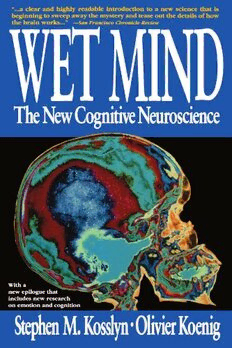Download Wet Mind: The New Cognitive Neuroscience PDF Free - Full Version
Download Wet Mind: The New Cognitive Neuroscience by Stephen Michael Kosslyn, Olivier Koenig in PDF format completely FREE. No registration required, no payment needed. Get instant access to this valuable resource on PDFdrive.to!
About Wet Mind: The New Cognitive Neuroscience
Five principles of Neural networks: 1. Division of labor. Because connections between input and outputs can interfere with each other, it is more efficient to have separate networks perform different mappings. 2. Weak modularity: Individual neural networks are not independent, discrete "module" within a larger system. One can analyze the black box of the neural network and figure out how it performed a particular task. The task is decided in advanced by someone who defines that task and completes the input/output mapping. Networks are great at generalizing but every task cannot be known. We learn about the implications of a theory by watching the way a model behaves. The extent the model can match the pattern of an organism response to stimuli the more serious we take the model. The logical exercise is to analyze which processing subsystem produces a specific behavior. 3. Functional relationship between subsystems. "We assume that a group of networks may work to compute complex input/output mappings, and so a processing subsystem may have an internal structure. In some case, the same subsystem may be a member of more than one processing subsystem." Some parts of the brain are like letters in a crossword puzzle, serving as components of more than one word and imply a break down in modularity. However, a network input/outputs works to compute one function. 4. Localization in the brain: Critical members of the network are localized to a specific area of the brain. However, not all neurons that sub serve a given computation needs to be in the same place. 5. Constraint Satification: The brain seems to use different sorts of information simultaneously and meet constraints, at the same time.Visual Perception: A visual stimulus based on the eye shifting brings the image into the attention window of the visual buffer. The attention window selects some region of the visual buffer for detailed processing. The pattern is sent to two subsystems: the ventral system and the dorsal system. The ventral system runs from the occipital lobe down to the inferior temporal lobe; the ventral system encodes information about key properties of shapes, colors, and textures. The dorsal system runs from the occipital lobe up to the parietal lobes; the dorsal system encode information about special relationships, guide movement, and special properities. The preprocessing subsystem extracts nonaccidental properties, such as, symmetrical edges, parallel lines, and point at the front and perceptual units, such as regions of the same color or blotches that have been proven distinctive in the past; hypothesis testing cycle is repeated until enough information has been encoded to implicate a particular object in associative memory.The outputs of the dorsal and ventral come together at the associative memory; associative memory pattern matches and gives meaning, a name, a category, and feeling about the object; the associative memory pattern match is a process of forming a hypothesis, verifying the hypothesis, and correcting and retrying again, if wrong; associative memory matches will not be exact. The associative memory causes an attention shift where the informative part from the lookup should exist; for example, patterns of eye movements observed when a person studied a picture of a person face suggest, the brain was using key lookup information to make identification; the attention shift moves the eye to key part locations for attention.
Detailed Information
| Author: | Stephen Michael Kosslyn, Olivier Koenig |
|---|---|
| Publication Year: | 1995 |
| ISBN: | 28740858 |
| Pages: | 616 |
| Language: | English |
| File Size: | 62.475 |
| Format: | |
| Price: | FREE |
Safe & Secure Download - No registration required
Why Choose PDFdrive for Your Free Wet Mind: The New Cognitive Neuroscience Download?
- 100% Free: No hidden fees or subscriptions required for one book every day.
- No Registration: Immediate access is available without creating accounts for one book every day.
- Safe and Secure: Clean downloads without malware or viruses
- Multiple Formats: PDF, MOBI, Mpub,... optimized for all devices
- Educational Resource: Supporting knowledge sharing and learning
Frequently Asked Questions
Is it really free to download Wet Mind: The New Cognitive Neuroscience PDF?
Yes, on https://PDFdrive.to you can download Wet Mind: The New Cognitive Neuroscience by Stephen Michael Kosslyn, Olivier Koenig completely free. We don't require any payment, subscription, or registration to access this PDF file. For 3 books every day.
How can I read Wet Mind: The New Cognitive Neuroscience on my mobile device?
After downloading Wet Mind: The New Cognitive Neuroscience PDF, you can open it with any PDF reader app on your phone or tablet. We recommend using Adobe Acrobat Reader, Apple Books, or Google Play Books for the best reading experience.
Is this the full version of Wet Mind: The New Cognitive Neuroscience?
Yes, this is the complete PDF version of Wet Mind: The New Cognitive Neuroscience by Stephen Michael Kosslyn, Olivier Koenig. You will be able to read the entire content as in the printed version without missing any pages.
Is it legal to download Wet Mind: The New Cognitive Neuroscience PDF for free?
https://PDFdrive.to provides links to free educational resources available online. We do not store any files on our servers. Please be aware of copyright laws in your country before downloading.
The materials shared are intended for research, educational, and personal use in accordance with fair use principles.

